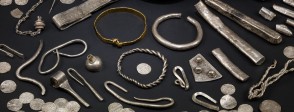Start off by familiarising the students with the hoard itself.
Use the photos and the zoomable image of the hoard on the History of the World site in For the classroom. Examine the contents of the hoard on the whiteboard or in small groups. Discuss the materials and the condition of the objects – some have been bent, others roughly cut. Discuss the value of silver to the Vikings – it was above all the silver the objects were made from, not the shape or design of the objects, that was valued. Compare this with currency and status symbols today.
The hoard offers a good opportunity to relate the Vikings to the wider world.
Ask students to locate on a map of the world the places the treasures in the hoard came from. Discuss how they could they have been transported to Yorkshire and how the owner may have acquired them. Students may come up with a variety of possibilities and can discuss the likelihood of each using the links in For the classroom.
Use the BBC Class Clip on Viking trade in For the classroom. Ask students to mark on the map the commodities the Vikings traded. Ask students about the religious buildings and objects shown in the clip. Which religions did the Vikings encounter when they travelled for trade? The clip focuses on Islam and Christianity. Point out the Islamic dirhams and the Carolingian cup, which is probably from a church, from the Vale of York hoard. Discuss what else may have travelled to Yorkshire along with the objects, for example, religious beliefs, fashions, cookery, stories, artistic styles.
Vikings wore silver to display their wealth. Ask students to look carefully at the jewellery in the hoard and to research Viking clothes. There are images of the jewellery and links to useful websites in For the classroom. Ask students to use their research to design an outfit for the high-status Viking who owned the hoard, including their jewellery.
Show students the video about the Bangor bell in For the classroom. Discuss how the monks who owned it might have felt about the Vikings and why. Compare the monks hiding the bell to the Viking owner of the Vale of York hoard hiding their belongings. Do students think the image of the Vikings as fierce raiders is a fair one? Why or why not?
The first of the enquiries that follow is quite focused; the second is wider-ranging.
What does the Vale of York Hoard tell us about its owner? The hoard is the only evidence we have of its owner or owners. Ask students to make statements they can be quite confident about, based on the evidence, for example, that the owners were rich because there was a lot of silver in the hoard. Then move on to what the students think they can tell from the evidence of the hoard itself and the context of its burial. What sorts of evidence would they like to have in order to be able to draw firmer conclusions?
What happened to the hoard’s owner? Why did the owner not return to the hoard? Ask students to use the links in For the classroom to find out what was happening in Britain in AD 927 when the hoard was buried. Ask students why they think the owner buried the hoard and what might have happened to them.
This set of activities focuses on the nature of hoards and uses the examples in A bigger picture.
Assign a group of students to each of the hoards. They should note the following:
- where each hoard was found
- what it contained
- the estimated date of burial
They could record the hoards on a map or on a timeline. Discuss what a hoard is and the possible reasons why someone might bury a hoard. Discuss how the contents of a hoard are the only clues we have to the owner and to the circumstances in which the hoard was buried. Ask each group to go on to interpret the evidence, thinking about who may have buried the hoard and why. Share the ideas and compare the hoards. What can and can’t the hoards tell us? Are there any similarities across time? Ask students why they think people throughout history have buried hoards.
As most hoards are typically buried to preserve them, ask students what precious belongings they would put in a hoard for safekeeping. This could lead to creative work, for example, writing about why or where their hoard is buried, what happens to it or how it is discovered and interpreted by archaeologists in the future.


